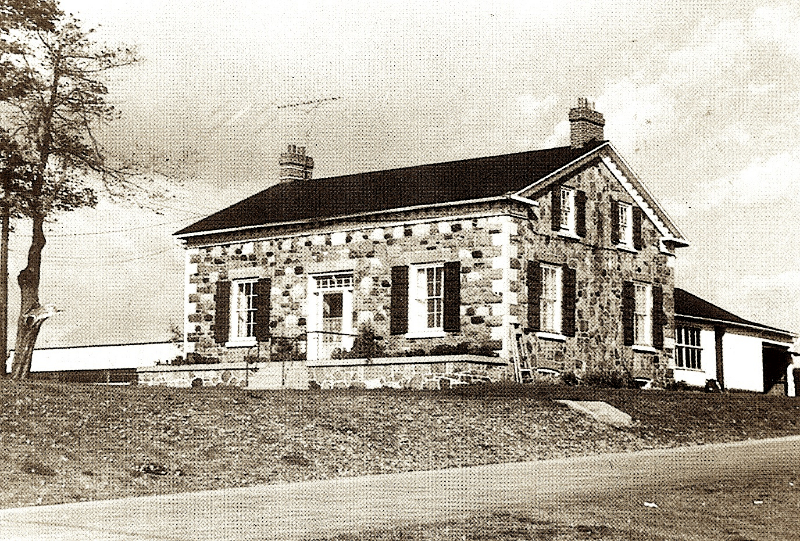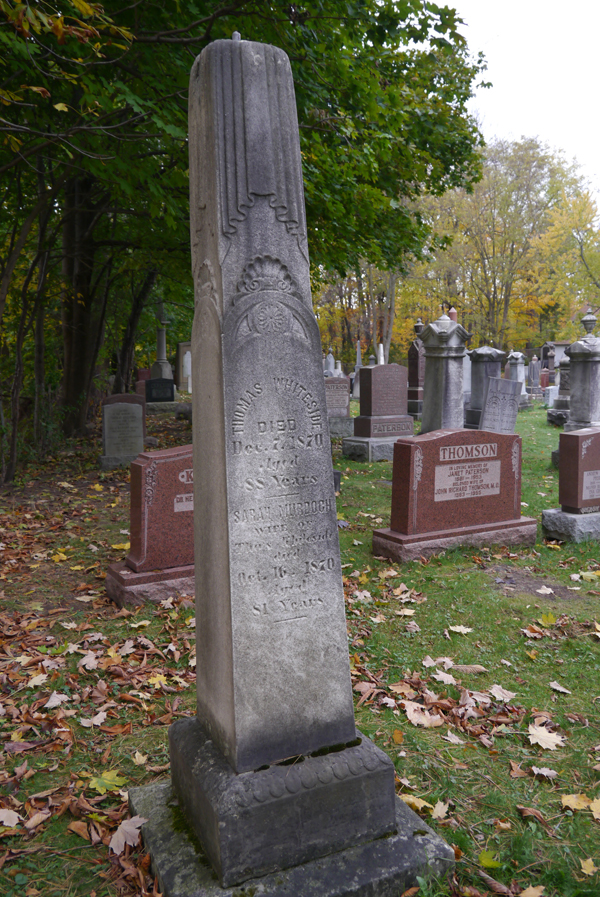In 1822, Thomas Whiteside of Belfast, Ireland was 40 years old, the average life expectancy for men in Great Britain at the time. But Thomas must have been an optimist because that was the year he and his wife, Sarah, 33, and their four children started their new lives in Upper Canada. When he and Sarah both died in 1870, they had lived in Canada for 48 years.1
Thomas prepared carefully for the move across the Atlantic, bringing with him three reference letters.2 The first, a character reference dated April 11, 1821, said that in the 16 years Thomas had lived in Belfast, he had behaved honestly and soberly, and was “in every way a decent respectable man.” The second stated that he had served loyally for nine years in the Belfast 2nd Company of Yeoman Infantry (a militia unit). The third noted that Thomas had been in the service of Mr. Thomas Battersby of Belfast for 15 years. Whether these references were helpful to Thomas once he reached Upper Canada is not clear, because he became a farmer and his own boss.

The Whitesides were one of many immigrant families, mainly from Scotland and Ireland, who settled in Scarborough in the 1820s. Today Scarborough is a sprawling suburb in the east end of Toronto, but at that time the area consisted of virgin forests and fertile agricultural soil. Thomas bought two properties in 1822 from Ebenezer Cavers: he paid 100 pounds for Concession I, Lot 22 and he also bought Concession II, Lot 29. Seven years later, he purchased the adjoining Concession II, Lot 28.3
According to the 1861 agricultural census,4 Thomas put half of the 100-acre Concession II, Lot 29 under cultivation for crops, producing primarily turnips, oats, peas and fall wheat. Twenty acres were pasture and 15 were left wooded. At that time, he estimated the cash value of the farm at $8000. At first, Thomas and Sarah lived in a log house. In 1854, they constructed a handsome stone house, which was demolished in 1989 to make way for a hotel.
Perhaps one reason Thomas and Sarah decided to leave Ireland was the ongoing political turmoil there. But Canada had its own problems in 1837 as rebels in both Upper and Lower Canada demanded more responsible government. A conservative in politics,5 Thomas no doubt disagreed with the rebels. According to a family story,6 Thomas and his two eldest sons, James (an ensign in the local militia) and Daniel, were involved in a skirmish between the untrained rebels and the local militia at Montgomery’s Tavern in Toronto. I have not yet been able to confirm that the Whitesides were there. Although the rebellion collapsed that day, a few years later responsible government was established in Canada.
The Whitesides brought their four young children with them from Ireland: Margaret (c. 1814-1874), James (c. 1816-1889), Jane (1817-1872), and Daniel (1819-1904.) Three more children were born in Canada: Sarah (1823-1894), Thomas (c. 1824-1914) and John (1833-1896).7

Margaret Whiteside married local farmer John Glendinning. Their daughter Isabella Glendenning (the spelling of the name has varied) married James Hamilton and moved first to Saskatoon, then to Winnipeg.8 They are my ancestors, making Thomas and Sarah Whiteside my three-times great grandparents.
Daughter Jane Whiteside married a local man, William Abraham, and daughter Sarah also married a man from Scarborough, John Crawford.
John, the youngest son, lived on Concession II, Lot 28 and married Margaret Brown.
According to several family trees on www.Ancestry.ca, he died in British Columbia.
Thomas Whiteside Jr. took over Concession II, Lot 29 and married Jane McCowan. In 1892 he sold his property in Scarborough and bought Glen Farm in Innerkip, Oxford County, Ontario.
Two of the Whiteside sons went far afield. James Murdoch Whiteside became a mining engineer and left for California around 1849. He spent most of his life in California with his wife Susan George and is buried in New Westminster, British Columbia. A few years later, his brother Daniel followed him to California and prospected for gold there, and in Australia and British Columbia. Daniel then went into the railroad construction business in California and lived in San Diego. After his first wife (name unknown) died, he married Ruth White. Daniel is buried in the same B.C. cemetery as James.9
Thomas and Sarah Whiteside died within two months of each other. The Whiteside gravestone in St. Andrews Presbyterian Church Cemetery, Scarborough, is tall and elegant and, although it is now discoloured, the words are still clearly legible. It reads, “Thomas Whiteside, died Dec. 7, 1870 age 88 years. Sarah Murdoch wife of Thos. Whiteside died Oct. 16, 1870 age 81 years.”
Notes and Sources
- Thomas’s death certificate puts his age at death as 89. It adds that he was Presbyterian, and was born in County Antrim, Ireland (now part of Northern Ireland.) At the bottom of the page, a note adds that Thomas and his wife came to Canada in 1822 and lived in Scarborough for 48 years. “Ontario, Canada, Deaths, 1869-1938, 1943-1944, and Deaths Overseas, 1939-1947” digital image, Ancestry.ca (www.ancestry.ca, accessed Nov. 7, 2016), entry for Thomas Whiteside, Dec. 7, 1870, citing Archives of Ontario; Toronto, Ontario, Canada; Series: MS935; Reel: 2.
- During a recent visit to the archives of the Scarborough Historical Society, I discovered these reference letters in a box of Whiteside family documents (Scarborough Archives, Whiteside Papers, Ref. # 1.04.29). They were donated to the archives in 1983 by Helen Richmond Smith (Whiteside) of Sidney, B.C.
- This information was provided by the Scarborough archivist from microfilm of the Ontario land records.
- “Census Returns For 1861; Roll: C-1087-1090,“ digital image, Ancestry.ca (www.ancestry.ca, accessed Nov. 7, 2016), entry for Thos Whiteside; Ancestry.com and The Church of Jesus Christ of Latter-day Saints, citing 1861 Census of Canada, Library and Archives Canada; Ottawa, Ontario, Canada.
- History of Toronto and the County of York Ontario, Volume II, Toronto: C. Blackett Robinson, publisher, 1885, p. 281.
- This story is mentioned in an article about the Whiteside family in a printed binder called James McCowan Family from 1833, p. 82, available on the bookshelf of the Scarborough Historical Society.
- The article on the Whitesides in the James McCowan Family from 1833, p. 82, lists the children of Thomas and Sarah and gives their birth and death dates. I looked for these individuals on www.Ancestry.ca, www.findagrave.com and www.familysearch.org and confirmed or corrected whatever I could find. Some of the birth dates are on the gravestones, others are calculated from age at death.
- Janice Hamilton, “Isabella Hamilton the North-West Rebellion,” Writinguptheancestors.blgospot.ca, Nov. 8, 2013, https://www.writinguptheancestors.ca/2013/11/isabella-hamilton-and-north-west_8.html.
- Most of the information about Thomas, James and Daniel Whiteside comes from the family history printed binder James McCowan Family from 1833, at the Scarborough Historical Society archives.
